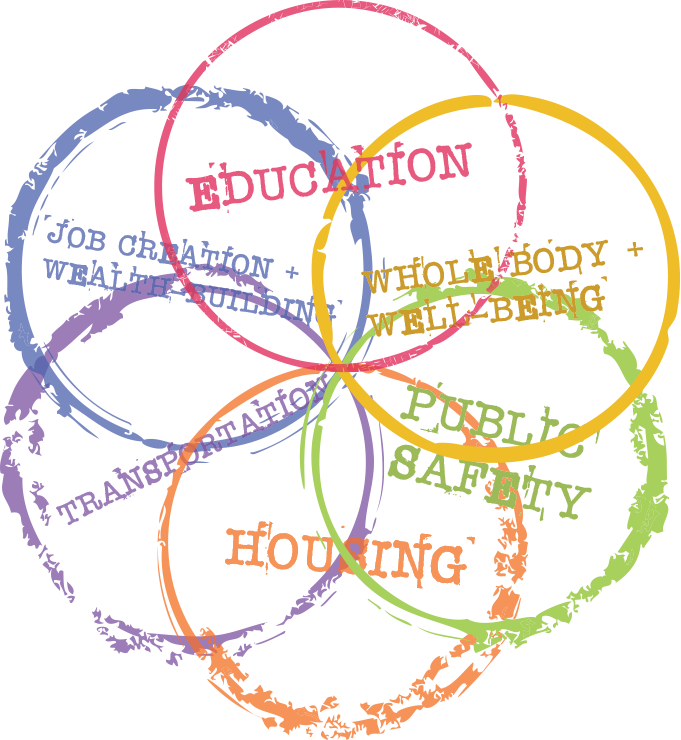It Takes Communities to Achieve Justice
By Adrienne Cole Johnson, L.T. Moon, Ram Bhagat and Trey Hartt
Published in the Richmond Times-Dispatch on August 13, 2016
Justice is a common theme throughout American history, with varying perceptions of goals and definitions along the way. While some may feel as though justice is alive and well, many, many citizens with a close pulse on the diverse communities of our country are identifying with a growing perception of the divide regarding just and fair treatment for individuals within the intersection of race, class, and culture.
Attempting to manage perpetual ongoing social problems that plague our communities, we struggle and have relegated to external institutions — which may be completely unfamiliar with the idiosyncratic characteristics of each community — the power to impose sanctions. This has ultimately led to community decline and to destabilization.
Blame it on social media, blame it on increased access to information, or simply blame it on reality — the microscope is narrowly focused on our society and we are forced to accept that there is still so much work to do. Richmond is no exception to these issues and it is important that we as citizens rise to the challenge of changing our approach.
Our belief is that justice is harder to achieve if the communities most affected are not involved in defining what justice is and actively working with policymakers to ensure it is achieved.
***
At its root, community justice encourages and supports community inclusion and partnership in all aspects of crime-reduction and prevention. More broadly, community justice is critical to positive growth and the development of strong, viable neighborhoods and should always be the preferred approach. It can facilitate a sense of empowerment, community care, and social cohesion among the members themselves who clearly have the greatest investment.
It is important to mention that community justice is not a new concept, just a newer name. As philosopher Paulo Freire described in his classic work, “Pedagogy of the Oppressed,” published in 1968, “the culture of violence must be changed by victims, the oppressed, who must not become perpetrators, but rather uplift the community through a process of self-healing.” This healing is a soft yet very important piece of community justice.
Leaning to individuals, groups and organizations that are doing authentic work in our communities around restorative justice, we know that each cultural community has the healing capacity to counteract social ills.
Drumming, dancing, spoken word, and many other creative outlets can reconnect, revitalize, and synchronize community in the most organic and authentic of ways. Community justice involves perpetrators and survivors of trauma-causing events and experiences engaging in trauma-healing circle processes, whereby participant communities can vigorously engage in the process of unpacking the experiences they have had, or are still experiencing.
We are also careful to mention that community justice is far more than political elections and involvement during the election process, even with the current state of electoral affairs for our city and our nation. This is just a portion of the aim of community justice. It is much more deeply rooted in the truest sense of democracy and equity, the concept that by listening to and developing policies, systems, and behaviors that sustain all parts of our community, we all benefit.
***
So how do we radically re-imagine what justice looks like in our communities? From whom should those ideas generate and how do we truly know when we have arrived at justice? While there is no singular approach to answering these questions, there is a multitude of work that can be done to get our journey started.
The City of Richmond Department of Social Services just hosted the first Adverse Childhood Experiences (ACEs) and Community Resilience Summit of 2016, and while it is amazing to know this was the first, it is quite encouraging to know that it is finally happening now. There is no better time.
This fall, we will debut a new film series entitled the Community Justice Film Series. This series is aimed at activating the everyday citizen to take steps toward community justice.
Focused on six themes — education, whole body and well-being, public safety, housing, transportation, and job-creation and wealth-building, the Community Justice Film Series will be a conduit for us to reflect, share, discuss, and take steps toward understanding what community justice looks like in Richmond and how we can hold each other and those in positions of power accountable.
You, as a unique member of the community, are encouraged to join us through film presentations and real dialogue as we work together to ensure that we are all engaged in defining what justice looks like for ourselves and for our neighbors.
We recognize that justice is a goal whose finish line is forever changing, and the process of action, reflection, and transformation is the ongoing approach that we must use. For in the end, community justice is not for the benefit of a few but, rather, the power of us all. We cannot move toward community justice without the participation of everyone.
